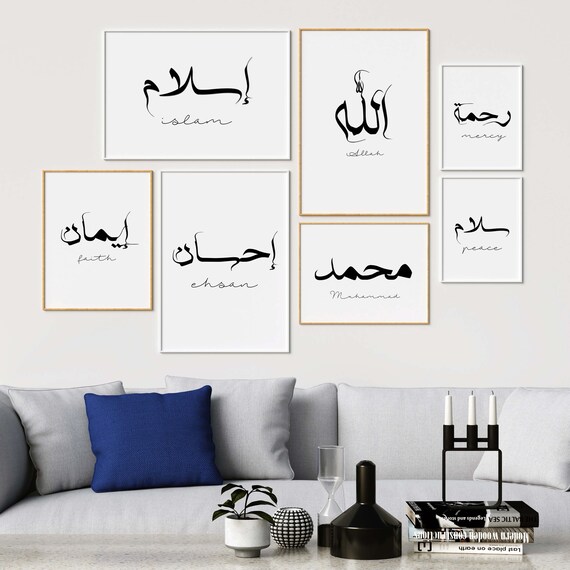Islamic wall art, or Islamic art, refers to visual artistic creations that reflect the cultural values and artistic traditions of Islamic societies. This art form often includes calligraphy, geometric patterns, and floral motifs, avoiding the depiction of sentient beings in accordance with many interpretations of Islamic law.
Islamic wall art serves as a decorative and inspirational element in homes and places of worship, often featuring verses from the Quran and other Islamic literature. Embracing a rich heritage that spans over 1,400 years, Islamic art is not only an expression of religious devotion but also a means of cultural transmission and aesthetic expression.
Its intricate designs and careful craftsmanship underscore the importance of beauty and spirituality in the Islamic world. As global interest in Islamic art grows, it continues to influence modern design and architecture, while remaining deeply rooted in the traditions of the past.

The Essence Of Islamic Wall Art
The Essence of Islamic Wall Art resonates with a profound cultural heritage. This art form is not just decoration. It embodies spirituality, history, and identity. Islamic Wall Art serves as a reminder of the philosophical and aesthetic values of Islam.
Roots In Islamic Tradition
Islamic Wall Art has deep roots in religious and cultural traditions. Originating over 1,400 years ago, this art reflects the essence of an entire civilization. Artists often draw inspiration from the Quran and Hadith. Their work aims to evoke contemplation and serenity.
-
Originates from historical Islamic societies
-
Reflects cultural and religious beliefs
-
Inspired by holy texts
Symbols And Meanings
Symbolism is key in Islamic Art. Artists use geometric patterns, calligraphy, and natural elements. Each symbol holds a special meaning.
|
Symbol |
Meaning |
|---|---|
|
Geometric Patterns |
Infinite nature of God |
|
Calligraphy |
Divine words of the Quran |
|
Arabesque |
Harmony in life |
Each piece tells a story. The viewer connects with the art on a spiritual level. Islamic Wall Art is not just seen. It is experienced.
Varieties Of Islamic Wall Art
Islamic Wall Art reflects a rich cultural heritage. It beautifies spaces with sacred patterns and texts.
Calligraphy And Typography
Islamic calligraphy stands as a fundamental element. Artists transform Arabic script into divine art.
Typography in Islamic art often features Quranic verses. These pieces serve as daily reminders of faith.
Geometric Patterns And Motifs
Geometric designs are a hallmark of Islamic art. They represent the infinite nature of the Creator.
Common motifs include stars, hexagons, and arabesques. They symbolize the universe's order and harmony.
|
Type of Art |
Features |
Symbolism |
|---|---|---|
|
Calligraphy |
Arabic script, Quranic verses |
Divinity, Guidance |
|
Geometric Patterns |
Stars, hexagons |
Infinity, Order |
Masters craft these pieces with precision. Each shape interlocks, creating a mesmerizing effect.
Cultural Significance
Cultural Significance of Islamic Wall Art speaks volumes. It reflects a rich heritage. Islamic Art intertwines with the history of a vibrant culture. This art form carries deep meanings and messages.
Influence On Muslim Culture
Islamic Wall Art has a profound impact on Muslim culture. It embodies spiritual and aesthetic values. This art form celebrates Islamic calligraphy and geometric patterns. It avoids the depiction of living beings.
-
Visual Representation of Quranic verses inspires believers.
-
Art pieces act as daily reminders of spiritual principles.
-
Cultural identity strengthens through shared artistic expressions.
Use In Religious Spaces
Islamic Art is integral in religious spaces. It beautifies mosques and prayer areas. Art serves a purpose beyond decoration in these sacred spaces.
|
Space |
Function of Islamic Art |
|---|---|
|
Mosques |
Creates an atmosphere of reverence and contemplation. |
|
Prayer Rooms |
Provides a focal point for worship and meditation. |
Art in these areas is more than beauty. It guides the faithful in their spiritual journey.

Materials And Techniques
Islamic Wall Art, or Islamic Art, is rich in history and culture. Artists use various materials and techniques to create stunning pieces. This art form is both traditional and modern, with diverse methods used to craft the artwork.
Traditional Crafting Methods
Traditional Islamic Art is known for its intricacy and attention to detail. Artists often use:
-
Wood: Carved with geometric patterns.
-
Metals: Such as brass and copper, for intricate designs.
-
Ceramics: Glazed tiles with colorful patterns.
-
Textiles: Woven with fine threads for detailed tapestries.
These materials are shaped using time-honored methods. Craftsmen employ tools like chisels and looms. They rely on skills passed down through generations.
Modern Interpretations And Media
Today, artists blend traditional styles with new techniques. They use modern media to express the timeless beauty of Islamic Art. These include:
-
Digital Art: Created with software for precision.
-
Photography: Capturing Islamic patterns in the real world.
-
Prints: High-quality reproductions of classic pieces.
-
Mixed Media: Combining different materials for unique effects.
In modern interpretations, artists explore new materials. They use acrylics, digital printing, and even laser cutting. This fusion creates a fresh perspective on traditional Islamic motifs.
Iconic Examples
Islamic Wall Art or Islamic Art captivates with its beauty and intricacy. This art form spans centuries, showcasing the rich cultural heritage of the Islamic world. The Iconic Examples of Islamic Art include both ancient and modern pieces. These works highlight the artistic excellence and spiritual depth of Islamic culture.
Famous Mosques And Their Art
Famous mosques around the world are treasure troves of Islamic Art. Their walls, ceilings, and domes display stunning craftsmanship. Here are some notable examples:
-
Al-Masjid an-Nabawi in Medina features breathtaking pillars and domes adorned with Islamic calligraphy.
-
The Blue Mosque in Istanbul is known for its intricate tile work and majestic minarets.
-
Sheikh Zayed Grand Mosque in Abu Dhabi showcases a blend of modern and traditional Islamic Art.
Contemporary Islamic Art Pieces
Modern artists continue to explore Islamic Art, creating pieces that blend tradition with contemporary themes. Notable works include:
-
Shirin Neshat’s photographs, which explore Islamic identity and femininity.
-
Wael Shawky’s video installations, which retell historical Islamic stories.
-
Ahmed Mater’s mixed-media works, which reflect on contemporary Middle Eastern culture.
These artists and their works show the dynamic and evolving nature of Islamic Art.

Integration Into Modern Decor
The Integration into Modern Decor shines a light on Islamic art's transition. This art form blends traditional motifs with today's interior design trends. It offers a unique aesthetic to any space.
Adorning Homes And Workspaces
Islamic wall art has found its way into various spaces. It adds elegance and a sense of peace to rooms. These pieces often feature intricate calligraphy and geometric patterns. They are used in living rooms, offices, and public areas.
-
Canvas prints bring verses and designs to life.
-
Wall decals offer a temporary yet impactful touch.
-
Metal art provides a modern twist with durable materials.
Fusion With Contemporary Art
Islamic art merges with modern styles to create unique pieces. Artists blend traditional Islamic elements with contemporary techniques. This creates a fusion that appeals to a wide audience.
|
Traditional Element |
Modern Twist |
|---|---|
|
Calligraphy |
3D Printing |
|
Geometry |
Digital Art |
|
Arabesque |
Minimalist Designs |
Such artworks fit well in contemporary decor. They often serve as conversation starters. They can also be the centerpiece in a minimalist setting. This blend shows the versatility of Islamic art in modern contexts.
Preservation And Conservation
The 'Preservation and Conservation' of Islamic Wall Art is vital. Islamic Art captures centuries of culture. It needs care to survive for future generations. This art includes intricate calligraphy, geometric patterns, and detailed paintings. They adorn mosques, homes, and museums worldwide.
Efforts To Protect Heritage
Global teams work to safeguard Islamic Art. UNESCO lists many sites as World Heritage. Groups raise awareness about the importance of these artworks. They fight against the threats of war, weather, and time.
-
Education programs teach about Islamic Art's value.
-
Legal protections prevent illegal trade of artifacts.
-
Technology monitors the condition of art pieces.
Restoration Of Ancient Artworks
Restoring ancient Islamic Art is a delicate task. Experts must understand the original methods and materials. They use old techniques to keep the art's authenticity.
-
Assess the artwork's condition.
-
Clean the piece with care.
-
Repair using traditional materials.
-
Document the process for education.
Conservation ensures that Islamic Art remains a testament to a rich cultural history. It connects us to a past filled with beauty and knowledge.
Purchasing And Collecting
The joy of Purchasing and Collecting Islamic Wall Art is unique. This art brings beauty and spiritual depth into homes. Collectors and enthusiasts find value in each piece. Whether for personal enjoyment or as an investment, the market for Islamic Art is vibrant.
Where To Find Authentic Pieces
Finding genuine Islamic Art requires knowing where to look. Consider these options:
-
Online galleries: Many websites showcase Islamic Wall Art. They offer a range of styles and prices.
-
Art exhibitions: These events often feature Islamic Art. Artists and galleries display their best pieces.
-
Local markets: In regions rich in Islamic culture, local markets may sell authentic art.
-
Auctions: Rare and valuable pieces often appear at auction. This option suits serious collectors.
Supporting Traditional Artists
Buying Islamic Wall Art does more than decorate a space. It supports artists and preserves traditions. Here's how to support them:
-
Buy directly: Purchase art directly from the artists when possible. This approach ensures they receive fair compensation.
-
Attend art shows: These shows offer a platform for artists to gain exposure. Buyers can meet artists and learn about their work.
-
Commission pieces: Commissioning art allows artists to create personalized pieces. It also provides them with a steady income.
-
Spread the word: Share your appreciation of Islamic Art on social media. This increases awareness and demand for their work.
Frequently Asked Questions
What Is The Origin Of Islamic Wall Art?
Islamic Wall Art originated in the 7th century, closely tied to the spread of Islam. It encompasses a diverse range of artistic expressions, including calligraphy, geometric patterns, and arabesques, designed to reflect the beauty of the divine without depicting living beings, adhering to Islamic teachings.
How Does Islamic Art Reflect Cultural Values?
Islamic Art reflects cultural values through its emphasis on unity, balance, and harmony. It avoids the depiction of living beings, focusing instead on abstract, geometric designs and calligraphy. These elements symbolize the infinite nature of Allah and the importance of the Quran, showcasing the deep spiritual and cultural significance of the art form.
What Materials Are Used In Creating Islamic Wall Art?
Traditional Islamic Wall Art utilizes a variety of materials, including ceramics, wood, textiles, and metals. Modern interpretations may also incorporate digital art forms and prints. The choice of material often enhances the intricate details and patterns characteristic of Islamic art, allowing for a diverse expression of artistic creativity.
Can Islamic Art Be Displayed In Non-religious Settings?
Yes, Islamic Art can be displayed in non-religious settings. Its aesthetic appeal, characterized by intricate designs and calligraphy, makes it suitable for diverse environments, including homes, offices, and public spaces. Its universal themes of unity and beauty allow it to transcend religious boundaries, making it appreciated by people of various backgrounds.
Conclusion
Exploring Islamic wall art reveals a rich tapestry of faith and creativity. It blends intricate designs with profound symbolism, offering a unique glimpse into Islamic culture. This art form enriches spaces, making them more than just visually appealing—they become spiritually resonant.
Embracing Islamic art is about appreciating beauty that transcends the ordinary, inviting reflection and peace into any environment.





